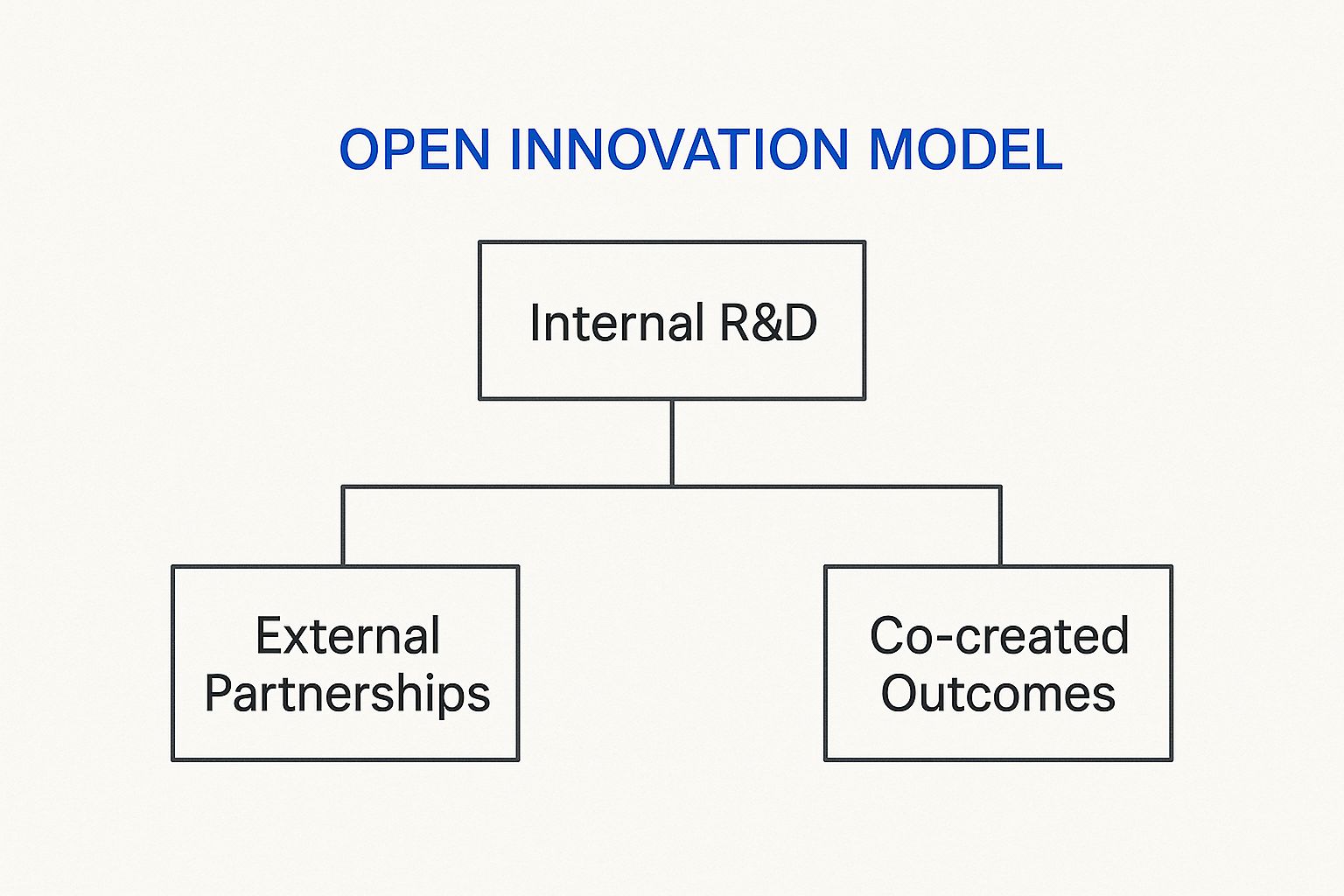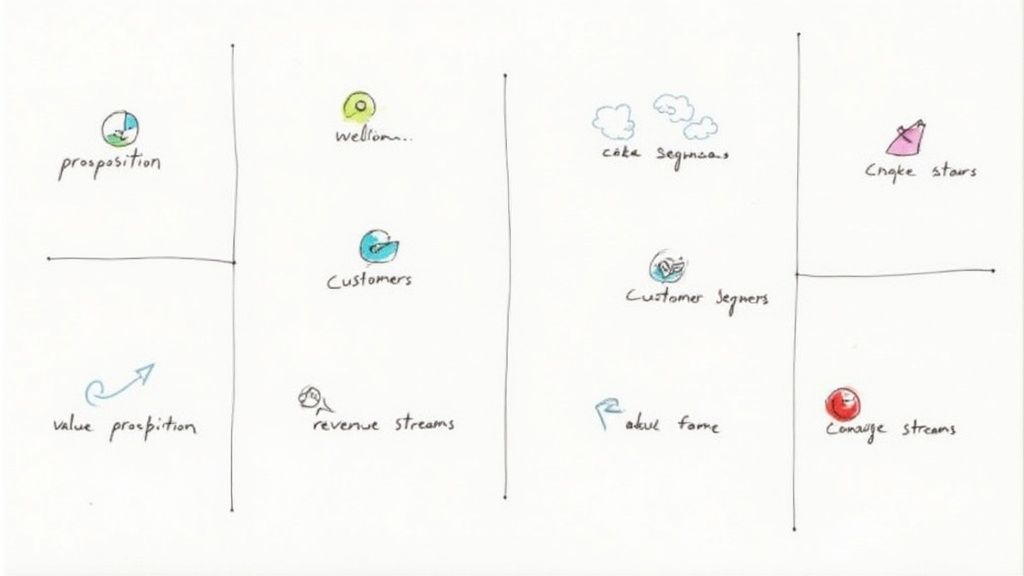Business Innovation Models: Drive Growth & Stay Competitive
Oct 7, 2025 in Guide: Explainer
Explore top business innovation models with real examples. Learn to select and apply frameworks that boost growth and keep you ahead.
Not a member? Sign up now
NILG.AI on Oct 7, 2025
So, what do we actually mean when we talk about a “business innovation model”? Let’s cut through the buzzwords.
Think of it as a repeatable recipe for growth. It’s the difference between occasionally getting lucky with a good idea and building a system that consistently churns out fresh, valuable concepts. A good model gives you a structured way to create, deliver, and capture value that keeps you ahead of the curve.

At its heart, a business innovation model is your company’s playbook for doing things differently to get better results. It’s how you turn random flashes of inspiration into a reliable engine for profit.
Consider the difference between a local food truck and a five-star restaurant. Both sell food, but their models couldn’t be more different. The food truck thrives on an agile, low-overhead model built for speed and convenience. The fancy restaurant, on the other hand, runs on a high-touch, premium experience model where atmosphere and service are everything.
Neither is right or wrong, but each has a clear, repeatable framework for serving its specific customers. That framework is their innovation model.
Without a solid model, “innovation” is just a collection of one-off projects that don’t really connect. A structured approach gives you a roadmap. It helps you focus your time and money, track what’s working, and build a company culture where new ideas are welcomed, not just stumbled upon.
It fundamentally shifts your thinking from just putting out fires to actively seeking out new opportunities.
An innovation model transforms creativity from a sporadic event into a reliable business process. It provides the guardrails and direction needed to ensure that new ideas align with strategic goals and actually make it to market.
This kind of system is what fuels sustainable growth. It puts you in a position to see market shifts coming, react smartly to what competitors are doing, and discover what your customers want before they even know it themselves.
To really get a grip on how these models work, it helps to see where they focus. Innovation isn’t just about dreaming up a new gadget; it can touch every single part of your business. A well-designed model usually hones in on one or more of these four key areas.
Here’s a quick look at the fundamental ways a business can innovate using a structured model.
| Innovation Type | What It Changes | Simple Example |
|---|---|---|
| Product Innovation | The core offering or service you sell to customers. | Apple launching the first iPhone, completely changing the mobile phone market. |
| Process Innovation | The internal workflows and systems used to create and deliver value. | Ford’s assembly line, which made mass production of cars efficient and affordable. |
| Marketing Innovation | How you communicate with and reach your target audience. | Dollar Shave Club’s viral video marketing, which disrupted the traditional razor industry. |
| Organizational Innovation | The structure of your company, its culture, and its partnerships. | Google’s “20% time” policy, allowing employees to work on side projects. |
By targeting these specific areas, a business can create change that is both meaningful and manageable, rather than trying to change everything at once.
Now that we have a feel for what a business innovation model is, let’s look at some in action. These aren’t just dusty old theories from a textbook; they are the strategic playbooks that have built some of the most dominant companies in the world.
By digging into these frameworks, you’ll start to see how different approaches to innovation can carve out a serious competitive edge. Let’s pull back the curtain on how these game-changing companies really operate.
Disruptive innovation is probably the one you’ve heard about most. It’s the classic David-and-Goliath story, where a small startup seems to pop up out of nowhere and completely upend an industry giant.
The big idea here isn’t about making a slightly better version of an existing product. Instead, it’s about launching something simpler, cheaper, or way more convenient that appeals to a group of customers the big guys have been ignoring. At first, the established players just shrug it off because the new thing isn’t “good enough” for their mainstream customers. But that’s the trick—it gets a foothold at the bottom of the market, then it improves, and improves, and improves, until it eventually kicks the old incumbents to the curb.
Disruptive Innovation: A process where a smaller, scrappier company successfully challenges established businesses. They start by targeting overlooked customers and then move upmarket to displace the leaders.
The perfect example? Netflix vs. Blockbuster. Netflix didn’t start by trying to beat Blockbuster at its own game of stocking thousands of new releases. Nope. They went after movie fans who were cool with waiting a day or two for DVDs in the mail, all for a subscription with no late fees—the absolute bane of every Blockbuster customer’s existence. Blockbuster completely ignored this niche, but as streaming got better, Netflix climbed the ladder and made the entire video store model a relic of the past.
The open innovation model basically takes the old, top-secret R&D lab and throws the doors wide open. Instead of hoarding all the brainpower and ideas inside the company, businesses using this model actively hunt for ideas, tech, and feedback from the outside world.
It’s all based on a simple belief: great ideas are everywhere, and collaborating with others can get you to a breakthrough much faster. This means teaming up with universities, startups, suppliers, and even your own customers. It’s a huge shift from the old-school, “we know best” approach.
This diagram shows how ideas from both inside and outside the company can flow together to create something new.

As you can see, it’s not a free-for-all. It’s a structured way of blending internal and external knowledge to build something together.
LEGO is an absolute master of this. Their LEGO Ideas platform lets fans submit their own designs for new sets. If a project gets 10,000 votes from the community, LEGO’s own team officially reviews it for a chance to become a real product. This doesn’t just give them amazing product ideas for free; it builds a passionate community that feels like they’re part of the brand’s story.
This one is a seriously clever pricing strategy. You sell the main product (the “razor”) for cheap—sometimes even at a loss. Why? To hook customers into buying the dependent, high-profit consumable product (the “blades”) over and over again.
Once someone buys the razor, they’re locked into your ecosystem. This model is fantastic for creating a reliable, recurring revenue stream and keeping customers loyal. The low upfront cost makes it a no-brainer for customers to jump in, and their ongoing need for the “blades” keeps the cash flowing.
The Razor and Blades Model: A business strategy where you sell a durable item at a low price to fuel sales of a high-margin, disposable companion product.
Think about your Xbox or PlayStation. The consoles themselves are often sold with razor-thin profit margins, if any. The real money is in the “blades”: the games, subscriptions like Xbox Game Pass, and all the digital goodies you buy in their online stores. Every console sold is a new long-term customer for these profitable extras. It’s the same exact logic with printers and their ridiculously expensive ink cartridges.
The subscription model has absolutely blown up, moving way beyond just magazines and newspapers. Here, customers pay a regular fee—usually monthly or yearly—to get continuous access to a product or service. This completely changes the game from chasing one-off sales to building lasting relationships with customers.
For the business, the golden prize is predictable, recurring revenue. It makes financial planning a whole lot easier. For customers, it’s all about convenience, avoiding a huge upfront cost, and always having the latest and greatest version.
The secret to winning with a subscription model is to constantly deliver enough value to stop people from canceling (what the pros call “churn”). This means you have to be obsessed with what your customers need and be committed to always making your service better. To nail this, companies have to get good at using https://nilg.ai/202504/data-driven-decision-making/ to understand what keeps subscribers happy and sticking around.
These are just a handful of the playbooks companies use to innovate and grow. To see how these ideas can be mapped out visually, you should check out these Business Model Canvas examples. Each model provides a different roadmap to success, proving that real innovation isn’t just about one magical “aha!” moment—it’s about choosing the right blueprint and executing it brilliantly.

A great business innovation model doesn’t just appear out of thin air. It’s nurtured by a much bigger ecosystem—one that includes national strategies, a strong educational system, and smart economic policies. To really get what makes innovation click, it helps to zoom out from the company level and look at the countries that are absolutely nailing it.
Think of it like farming. You might have the best seeds in the world (your business idea), but if the soil is bad and there’s no water, you’re not going to get much of a harvest. The world’s top nations are masters at creating that fertile ground where new ideas can take root and flourish.
So, what’s the secret sauce? What do these countries that consistently top the innovation charts have in common? It really comes down to a few key ingredients that create a powerful, self-sustaining cycle of creativity and growth. These nations don’t just wait for breakthroughs; they build the very infrastructure that makes them almost inevitable.
This kind of national support is the bedrock upon which powerful business innovation models are built. The most successful environments tend to share these traits:
By getting these things right, countries become magnets for talent, capital, and ambitious ideas, turning them into global hubs for what’s next.
The Global Innovation Index (GII) gives us a fascinating snapshot of who’s leading the pack. In the 2025 report, Switzerland clinched the top spot for an incredible 15th consecutive year, a testament to its exceptional creative output and all-around strength.
Sweden and the United States held their ground at second and third. Sweden really shines with its high number of researchers and massive R&D spending, while the U.S. is a powerhouse in market sophistication and corporate R&D investment. You can check out the full GII 2025 results for a deeper dive.
These leading countries prove that world-class innovation is no accident. It’s the direct result of a deliberate, multi-faceted strategy that weaves together government, academia, and industry into one collaborative powerhouse.
The data makes one thing crystal clear: the best business innovation models are most potent when they have a rock-solid national framework supporting them.
One of the coolest things you see in these top-ranking countries is the rise of innovation clusters. These are basically geographic hotspots where you find a dense concentration of interconnected companies, specialized suppliers, and other institutions all focused on a particular field.
Think of Silicon Valley. The San Jose-San Francisco area is ranked as the world’s top innovation cluster for a reason. It isn’t just because giants like Apple and Google are there. It’s the entire network—the venture capitalists, elite universities like Stanford, and a deep pool of skilled workers—that makes the region a supercharged engine for new ideas.
This clustering effect creates some massive advantages:
Ultimately, these hubs prove that while a single company can have a brilliant innovation model, its true potential is unlocked when it’s part of a dynamic and supportive environment.

Let’s be clear: artificial intelligence isn’t just another tool in the business toolkit anymore. It’s a foundational force that’s fundamentally rewriting the rules of innovation. AI is shifting the entire game from simply creating a great product to building smarter, more agile processes from the inside out.
This is a real turning point. We’ve moved past the buzzwords and are now seeing practical, high-impact changes in how companies operate and compete. Today, innovation is just as much about the intelligence inside the process as it is about the final product that lands in a customer’s hands.
One of the biggest waves we’re seeing is the adoption of agentic AI. Forget simple chatbots; think of these as smart, autonomous systems that can make decisions and learn as they go. They’re completely overhauling operations across the board.
For instance, an agentic AI can juggle complex supply chain logistics, see disruptions coming a mile away, and automatically reroute shipments to sidestep delays. In customer service, these agents handle complex problems without needing a human to step in, which frees up your team for more strategic, high-value work.
The real magic of agentic AI is that it doesn’t just follow a script—it actively works toward a goal. This autonomy gives businesses a level of speed and efficiency that was previously unthinkable.
This shift toward intelligent automation is truly redefining what it means to be a responsive, modern organization. It unlocks the ability to scale in ways that were simply impossible with human-only teams. If you’re curious about getting started, we have a great guide on how to implement AI in business that breaks down the practical steps.
Another area where AI is completely changing the game is hyper-personalization. For years, companies have dreamed of delivering truly customized experiences, but doing it for everyone at once was the roadblock. AI is finally breaking down that barrier.
By crunching massive amounts of data on customer behavior, AI algorithms can craft unique, one-to-one experiences for millions of people at the same time. This is so much more than just sticking a first name in an email.
This ability to connect with customers on such a precise, individual level is setting a whole new standard for engagement and loyalty.
AI is forcing a structural change in business strategy, and its impact is only going to grow through 2025 and beyond. As more leaders pin their growth on innovation, they’re turning to agentic AI to fine-tune everything from customer support to back-end operations.
This isn’t just about tweaking old models. It’s a fundamental move away from being purely product-focused to an integrated approach where smart services and processes are at the core. The new pillars of innovation are agility, data, and a seamless collaboration between people and machines.
We’re seeing this play out in industries like telecommunications, where companies are mixing generative AI with other tech to build up their internal muscle and rely less on outside vendors. By weaving intelligence directly into their core functions, they’re creating business models that are far more resilient and adaptable. At this point, integrating AI isn’t just an option—it’s becoming the main engine for competitive advantage and sustainable growth.
Let’s be honest: a business innovation model isn’t something you create once, frame, and hang on the wall. The ones that actually work and deliver lasting success are alive—they have to be dynamic and built to flex when things get chaotic. And these days, chaos is the new normal, with everything from supply chain shocks to sudden political shifts and lightning-fast tech changes.
An approach that was brilliant yesterday can quickly become a liability tomorrow. This forces us to think bigger about what innovation even means. It’s no longer just about the cool product you sell or the software you build. Real, durable innovation now includes making smart, agile decisions about where you operate, how you find talent, and who you partner with.
If you want to build a resilient company today, you have to think geographically. More and more businesses are realizing that their physical footprint—where they put their factories, their R&D labs, and their teams—is a massive part of their innovation strategy. This isn’t just about chasing lower costs anymore; it’s about building an operation that’s both tough and responsive.
This idea is what we can call geographic innovation. It’s about turning your location into a strategic weapon. It means being nimble enough to move operations closer to key markets, diversifying your supply chain to sidestep bottlenecks, or setting up shop in a new region just to tap into its unique talent.
Here’s what that looks like in practice:
In every case, the company isn’t just tweaking a process. It’s fundamentally rethinking its physical and operational setup to win in a world that’s constantly in flux.
This isn’t just a theory; big players are already making these kinds of moves. As the global chessboard shifts, businesses are actively redesigning how they work to handle the uncertainty. Analysis from Boston Consulting Group shows many companies are planning major production relocations by 2025 to dodge risks. For instance, one U.S. tech hardware firm plans to move 90% of its North American production from China to Mexico and Southeast Asia. Meanwhile, a top automotive supplier is shifting R&D from Japan to China to get closer to the local electronics scene. You can read more on how global businesses need a new operating model on BCG.com.
These strategic moves teach a critical lesson for any leader today.
A truly resilient business innovation model sees the entire operating structure as a source of competitive advantage. It must be flexible enough to absorb systemic shocks and agile enough to pounce on geographic opportunities.
At the end of the day, your innovation model has to cover it all, from the design of your product right down to your company’s place on the world map. When you embrace that broader view, you can build a business that doesn’t just survive change but actually leads through it.
Knowing the different types of business innovation models is one thing, but actually making one work for your company? That’s where the real work begins. This isn’t about chasing the latest trend or picking a framework that sounds good on paper.
A model that sends a tech startup into the stratosphere could be a total dud for an established manufacturing company. The key is to find the perfect fit for your company’s unique DNA.
Let’s move from just learning about innovation to actively building it. That means taking a good, hard look at who you are as a business and creating a practical plan to bring your chosen model to life. It’s all about matching the right strategy to your situation, resources, and goals.
Before you can pick the right path, you have to know where you’re starting from. Seriously, don’t skip this part. Jumping into a new model without this groundwork is a classic mistake and a fast track to failure.
Start by asking some tough questions to get a clear, honest picture of your organization right now. This initial gut-check will act as your compass, pointing you toward models that make sense and away from those that will just create friction.
Think about these four areas:
Answering these will help you narrow down the list of business innovation models to the ones that could actually work for you.
Okay, so you have a better sense of your company’s reality. The next step is to tie your innovation efforts directly to your main business goals. An innovation model without a clear purpose is just a fun side project. It has to be a tool that helps you achieve something real, like growing revenue, breaking into a new market, or just making your operations run smoother.
Your innovation model should be the engine that drives you toward your most important business milestones. If it’s not directly supporting a key objective, it’s not the right model for you.
For example, if your big goal is to attract a younger audience, a disruptive or open innovation model could be a fantastic choice. But if you’re trying to squeeze more profit from your existing customers, something like a subscription or razor-and-blades model might be a much smarter bet.
Getting this alignment right is also how you get leadership on board and secure the budget you need to make it happen. It turns a fuzzy idea like “we should be more innovative” into a concrete strategy with a clear payoff. Mapping these steps out is a huge part of building a solid digital transformation roadmap for your company.
Choosing the model is the easy part. Making it real? That’s a whole different ballgame. This is where so many great innovation strategies just fizzle out. Success takes more than a good idea—it requires a real commitment to building a culture that can actually support it.
Be ready to tackle the inevitable roadblocks. People naturally resist change, so clear and constant communication from the top is absolutely essential. Your team needs to hear the “why” behind the new direction, not just the “what.”
And finally, start small. Don’t try to change everything overnight. Run a pilot project to test your chosen model on a limited scale. This gives you a chance to learn, tweak things, and build some positive momentum before you go all-in. It’s a much safer way to turn a scary change into a manageable and even exciting journey.
At NILG.AI, we help businesses turn innovation from a buzzword into a reality. Our experts can help you identify the right AI-powered strategies and build a clear roadmap for growth. Request a proposal
Like this story?
Special offers, latest news and quality content in your inbox.
Oct 7, 2025 in Guide: Explainer
Explore top business innovation models with real examples. Learn to select and apply frameworks that boost growth and keep you ahead.
Oct 6, 2025 in Listicle: Round-up
Discover 10 actionable digital transformation best practices. Learn how to drive growth with strategic insights for AI and data-focused businesses.
Oct 6, 2025 in Guide: How-to
Learn how to conduct SWOT analysis with this practical guide. Get actionable strategies, real-world examples, and proven tips for strategic business planning.
| Cookie | Duration | Description |
|---|---|---|
| cookielawinfo-checkbox-analytics | 11 months | This cookie is set by GDPR Cookie Consent plugin. The cookie is used to store the user consent for the cookies in the category "Analytics". |
| cookielawinfo-checkbox-functional | 11 months | The cookie is set by GDPR cookie consent to record the user consent for the cookies in the category "Functional". |
| cookielawinfo-checkbox-necessary | 11 months | This cookie is set by GDPR Cookie Consent plugin. The cookies is used to store the user consent for the cookies in the category "Necessary". |
| cookielawinfo-checkbox-others | 11 months | This cookie is set by GDPR Cookie Consent plugin. The cookie is used to store the user consent for the cookies in the category "Other. |
| cookielawinfo-checkbox-performance | 11 months | This cookie is set by GDPR Cookie Consent plugin. The cookie is used to store the user consent for the cookies in the category "Performance". |
| viewed_cookie_policy | 11 months | The cookie is set by the GDPR Cookie Consent plugin and is used to store whether or not user has consented to the use of cookies. It does not store any personal data. |